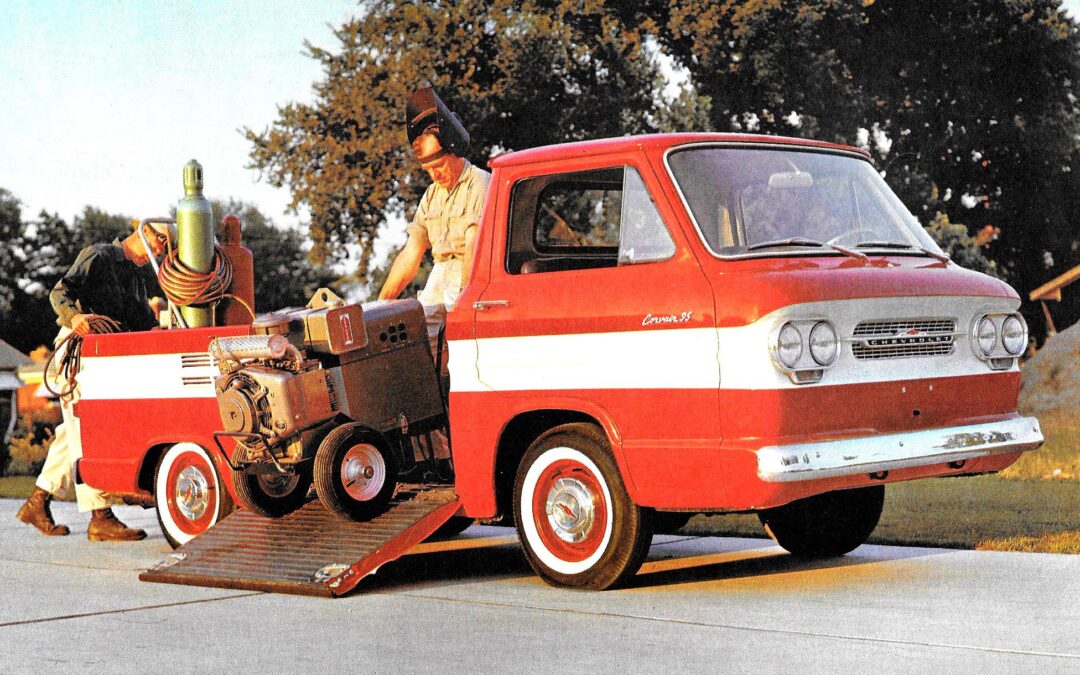Despite decent sales in 1960, the revolutionary designed and styled Corvair was a flop compared to Ford’s more conventional Falcon that outsold it two to one at more than 435,000 units.
The Corvair brochure had stated this car, “…doesn’t need power steering, power brakes, a radiator, a waterpump, anti-freeze, or even water,” yet that wasn’t enough for buyers in these conservative times. The Corvair was like Rock n Roll -too non-conformist and revolutionary?!
At the same time, America was starting to change in this new decade and thus, sales increased in 1961; albeit with help of a much expanded model line-up. The bulk of the sales were due to the sporty appeal of the Monza version with its four-speed, all-synchromesh transmission. It was an era when sporty cars and rallying were starting to capture more and more enthusiasts’ interests.
Also hot, were pickup trucks and as a result, a stylish, new 1961 Corvair 95 pickup was added to the line-up. It came in two versions -a somewhat more traditional Loadside and the extra-versatile Rampside.
The Loadside had a traditional rear tailgate, while the Rampside had the rear tailgate and handy rightside loading ramp.
With its wide pickup box and a flat floor the Corvair 95 pickups featured 80 cu.ft. of cargo space. The deep, amidships well boosted the cargo space. The optional three-section floor to provide a flat cargo box was available at extra cost.
The Corvair 95 pickups were available with a host of attractive options such as a chrome package, numerous driver comfort upgrades, two-tone paint, whitewall tires and full wheel discs.
The number “95” stemmed from the pickup truck’s shorter 95-inch wheelbase.
Chevrolet continued to brag about its new air-cooled powerplant design.
“It’s the most dramatic automotive development in decades, combining a totally new engine and transaxle drive unit into a remarkable compact, lightweight power package!”
Although the Corvair 95 looked like a COE design, its air-cooled engine sat in the rear following its sibling namesake car line-up. The ½-ton pickup’s overall design featured styling cues seen on the car line-up to tie-in the family resemblance, but still retained a distinctive look with its additional chrome and unique front grille.
The “95” had an 80 hp, 145 cu.in. air-cooled, six cylinder engine when introduced, but would grow in cubic inches and horsepower over the next few years. The side vents above the rear wheelwells were the first clue this truck was a rear-engine pickup.
Power from its air-cooled, horizontally-opposed, four-cylinder engine was transferred via a standard 3-speed, optional 4-speed manual, or a Powerglide two-speed automatic.
The biggest flaw in this unique pickup concept was its uneven bed floor which made loading difficult to the point where it was easier to drop things in from the side – truly a Loadside. Despite an optional plywood and angle iron section that provided a flat floor, this was an awkward addition to consistently install and remove.
The Loadside Corvair 95 was not a sales success and a mere 2,844 were built over a two year period, while, the easier loading Rampside sold in promising numbers in 1961 with 10,787 being built.
A better idea was the Corvair 95 Rampside which featured a heavy-duty cargo ramp that swung down flush with a deep well at the side of the cargo box. The 4-foot wide opening allowed heavy equipment and freight to be loaded without lifting or hand trucks and wheeled equipment to be easily rolled on-board. The loading floor was less than 14-inches off the ground, which was 10-inches less than Ford’s Econoline pickup. When closed, the ramp fit flush with the side of the box and was secured by double-spring locks, as well as a safety catch. The top edge of the ramp door was padded to help avoid damage when loading.
A popular option on the Rampside was the easily fitted and removed level-load floor which covered the nearly 28-inch well to provide a flat floor in the entire rear box. When in place the cover created a sizable storage compartment that was secured when the ramp door was closed.
The side ramp on the Rampside was a novel idea that never caught-on even though it combined the economy of an air-cooled engine, the Covair 95’s relatively low price and a hefty cargo capacity.
As well as hauling convenience and capabilities, Chevrolet also promoted the Corvair 95 on its cab comfort. The roomy interior featured a full-width flat floor with the absence of engine heat and noise. Big door openings, a deep-cushioned, full-width benchseat and plenty of options such as a right-hand sunshade, left-hand armrest, cigarette lighter and bright instrument panel trim provided a pleasant driving environment.
Alas, that number fell to less than half in 1962 and basically half again in 1963.
By 1963 with the Corvair 95 Loadside pickup truck was dropped from the line-up, while the Rampside continued and was powered mid-year by a 102 hp air-cooled engine.
And, although Corvair production exceeded well over 200,000 units in 1963, that included just 2,046 Rampside pickups. In 1964 only 851 Rampside pickups were built and so production was halted. In this final year a 164 cu. in. engine was available rated at 95 hp or 110 hp.
In 1965 with a new body style came a smaller Corvair range that consisted of a convertible, and a two and four-door hardtop. There was no new pickup truck version considered.
Total Loadside production was just 2,844 units, whereas the initially more popular Rampside had a final production number of 17,786 trucks.
The Rampside with its unibody construction couldn’t withstand the rigorous daily toil or the eventual inherent rust.
Today, there are relatively few survivors of this unique American-built half-ton pickup, yet surprisingly the prices compared to the equivalent, traditional Chevrolet or GMC hauler are much lower. It’s a buyer’s market at the moment, but don’t wait.

